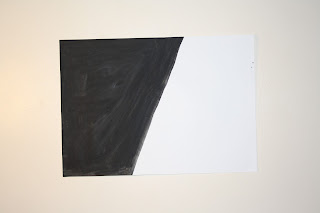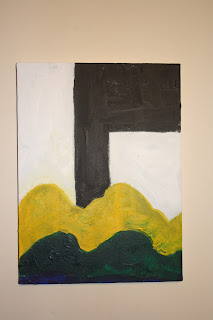For my exhibition I chose the topic of 'collections' as i proposed to exhibit a collection of prints representing urban and rural landscapes. The installing of my exhibition caused me problems as my prints, as they were small sizes, looked lost against the plain white wall and weren't easily distinguishable so i had to make a few changes. I incorporated tape that matched the colours of the prints and arranged the tape as a border, after i did this the prints became their own against the wall which changed the whole look of the exhibition. The tape was arranged ina structural formation to tie in with the theme of the urban. If i was to install the exhibition again i would choose to frame the prints different so it enhanced the visual qualities.
Fine Art
Wednesday, 10 May 2017
Plaster casts.
These plaster casts are the result of experimenting with material and space, each are intended to represent a different landscape. For the top cast i made a rectangular frame and placed it up against a building, the result (although cracked) was a formation kept inside the rectangle which to me represented the structural elements of a building. The second cast was produced by pouring plaster directly onto the floor resulting in a much more free flowing and expressive composition which fits perfectly into my idea of the two landscapes contrasting each other. My next step is to create much more detailed casts or sculptures based on these and then add colour, line and shape to match the landscapes accordingly.
Paintings using line and block colour.
These are paintings derived from my quick on sight experimentations, although simple they offer a clear contrast into how i viewed each landscape. The images using line and block colour are symbolic of urban landscapes, representing the structural qualities and the mundane colour scheme. The much looser, abstract paintings symbolise the rural landscapes which are much more vibrant and expressive to the eye which invokes a completely different approach to the painting itself with the use of colour and a different use of brushstrokes. Some paintings are works in progress but i intend to use these designs in the etching workshop and develop them further.
Drawings and paintings.
These drawings and paintings were done on location to support my photography work and for me to gain an insight into the contrasting elements of rural and urban landscapes. These pieces of work are development pieces and are quick 2-3 minute experimentation's.
Abstract/expressionist paintings for etching workshop.
To aid us in the etching workshop we were asked to produce paintings/drawings derived from using abstract and expressive mark making. As my work primarily involves urban and rural landscapes i decided to listen to documentaries and use descriptive words used to create these paintings. During the documentaries words such as flowing, rolling, square, rigid etc.. were used which invoked the different techniques in using marks.
Tuesday, 9 May 2017
Etching workshop and results.
Following the print workshop i chose etching as my extended workshop choice so i could experiment with different techniques and further my skill base. \The workshop was focused around the basic etching techniques which were hard and soft ground, aquatint and sugar lift or using a combination of more than one. As a basis we were asked to produce paintings or drawings which were created by listening to sound and recording what we heard using expressive and abstract mark making techniques.
My etchings were directly representative of the formal elements of line and shape, aiming to incorporate visual qualities of abstract landscapes contrasting, the shapes used which are straight edged and aligned in formations are inspired by the Neo-Concrete movement which originated in Brazil in the late 1950's. The shapes are figments of urban landscapes which i have researched in my paintings and photography work. The line work is mainly inspired by Howard Hodgkin who produced large scale etchings using sugar lift in which he would paint directly onto the copper plate so that his prints would have expressive, abstract marks. The lines represent the flowing nature of rural landscapes.
Subscribe to:
Comments (Atom)

















































